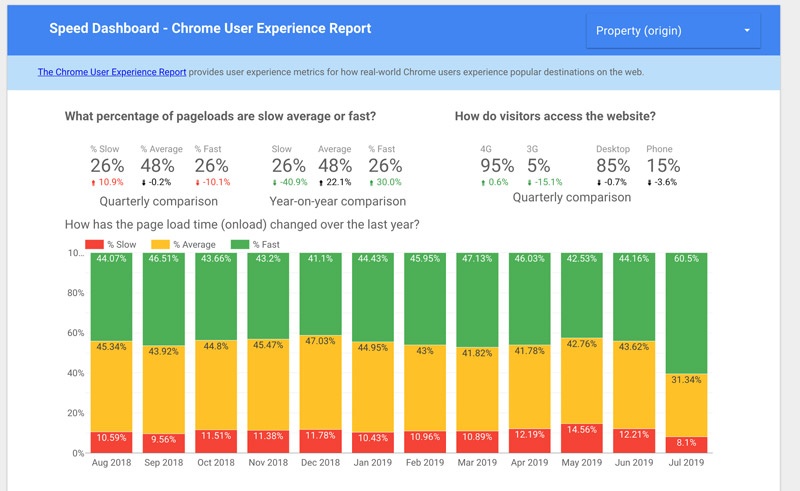When it comes to SEO and page speed, it’s all about the right approach. Consider Google reports over half its users will navigate away from a page that takes more than three seconds to load. Plus, the Google algorithm penalizes you in search rankings when your site is too slow, especially in mobile search results. After all, it’s in Google’s best interest to help searchers find sites that suit their needs. And If your site has long load times, chances are you’re not what their users want. So, how can you get up to speed?
How Do Recent Google Web Vitals Updates Impact SEO and Page Speed?
Google made page speed more relevant with the recent Web Vitals update, which helps brands better quantify their site’s speeds and other relevant metrics. With these Google tools, it’s crucial to ensure you’re not missing the mark. If the competition is already using Core Web Vitals to improve their own site speed, you’re already at a disadvantage. Moreover, a Google spokesperson has confirmed that sometime in 2021, Core Web Vitals metrics will be prime ranking factors for position in search engines. Now is the time to start optimizing!
The new Core Web Vitals from Google helps site owners develop a more user-friendly site by tracking three important aspects of the user experience: loading, interactivity, and visual stability.
- Largest Contentful Paint (LCP) measures the loading time. LCP measures how long it takes for page content to download and be ready for interaction. The largest block of context or image within the user’s view is measured, and anything beyond that screen doesn’t count. Elements measured usually include background images, paragraph tags, images, and video poster images. When it comes to loading times, LCP should occur within 2.5 seconds.
- The First Input Delay (FID) metric measures interactivity. FID tracks the delay between a user’s input and the time it takes for the site to respond. When a user clicks on a link, it can take less than a second to get to the page or it may take a few seconds to load. The initial experience is preferred, so sites that pass this test should have an FID of 100 milliseconds or less.
- Cumulative Layout Shift (CLS) tracks visual stability. Google manipulates page movement to measure how much each of the individual elements shift to determine CLS. An example is a user attempting to click a link on a page and experiencing a shift in movement that makes it impossible, resulting in a poor user experience. The measurements are done in fractions, and sites with good CLS metrics should be below 0.1.
When evaluating your site using the Core Web Vitals metrics, you should aim to reach the 75th percentile of page loads across mobile and desktop devices for all three analytics. The goal is to provide a superior interactive experience for users with no lagging or misdirection. There are a number of tools that can be used to measure this aspect of the user experience, including the Chrome User Experience Report. Galileo Tech Media regularly monitors these reports and numerous other factors as part of regular site maintenance for optimum performance at all times.

Breaking Down Load Times
Beyond its Core Web Vitals update, Google currently measures a number of other speed-related factors. These, by extension, factor into your search ranking. Keep an eye on the following on a regular basis:
- Server response (how long it takes your server to respond to a request for your site). To monitor, type ping at the command prompt followed by the site’s IP address then enter to see the time the server took to respond.
- First contentful paint (how long it takes content to appear once your site begins to load). If you fail to hit the desired 75th percentile, possible solutions include HTTP caching, less JavaScript work, and compress text-based assets.
- First meaningful paint (how long it takes helpful content to appear). Ways to speed up the content include improve the user interface rendering, add HTTPS and redirect to it, and include a manifest file for directories.
- Speed index (the average amount of time it takes to display your site’s visual elements). With mathematics in mind, the goal is to measure the progress of a web page loading between specific markers, while considering the percentage of elements that continue to remain unloaded.
- First CPU idle (the point at which users can start to interact with your site). Keep in mind that 0 – 2.2 seconds is excellent, 2.2 – 5 seconds is fast, and more than 7 seconds is slow.
- Time to interactive (when your site is fully ready for user interaction), Determining time to interactive involves three stages. First, pick a starting point, such as First Contentful Paint. Then, look for a window when the network remains stable for 5 seconds. Finally, look to the end of the last long task to determine the time as time to interactive.
- Max potential first input delay (the longest wait time a user might experience). Simple ways to improve this experience are choosing fonts and images that take less time to load.

Important Factors Influencing SEO and Page Speed
Based on this information, it matters how your site is hosted. This means that choosing a WordPress site versus a site hosted by Squarespace or BlueHost could yield very different results. Additionally, the up time or downtime that server has will play a role in your site’s load time. It’s important to do your research before settling on a host.
Similarly, working with an out-of-the-box site or one relying on a CMS may lead to slower load times. If you choose to work within a Wix template, for instance, chances are good the site will need to run quite a bit of Javascript before it can fully parse your site’s HTML. This can significantly increase your site’s load time.
While web developers debate about out-of-the-box website hosts, the WordPress CMS continues to be a leader for those who prefer not to use their own server. Robust content management services with countless options for customization coupled with reliable hosting make WordPress the top choice for leading corporations around the world.
Image Speed Solutions
Photos, videos, and high-resolution graphics are all major factors in slow page speed. Consider using lazy loading techniques to allow images to populate as a user navigates to relevant parts of your site, rather than requiring them all to load before the site is fully interactive. By loading essential content first, a site’s reportable load time can be much improved. Ways to ensure Googlebot sees all the page content include:
- Load content when it is visible in the viewport with a JavaScript library that supports this action, native lazy-loading for images and iframes, and IntersectionObserver API and a polyfill
- Support paginated loading when using infinite scrolling.
It’s also a smart idea to use image caches when possible. This is helpful when repeat users navigate back to your site. If the images are cached, it means that they’re stored in the user’s browsing history. As your site is loaded for a second time, the images come from the user’s browser, rather than from your server. This helps to increase page speed. Here are a few tips:
- Compress your image sizes when possible to 50 kb or fewer if a typical on-page photo, and 100 kb if a page header or very necessarily large image.
- Generally speaking, you’ll also save on site speed if you convert graphics to .gifs, regular photos to .jpgs, and images that need to be able to scale easily as .png files.
Coding Changes and Page Speed
The way your site is coded can impact how quickly it loads. As mentioned above, remove unnecessary Javascript whenever possible. In addition, any code that requires external interaction during the loading process will slow your site down.
Keeping your site’s code as simple as possible helps reduce loading times, too. Avoid roundabout coding methods and use the most basic-possible approach to achieve your coding goal. If you have outdated code for features that aren’t even displayed on your site anymore, this is a great first place to cut.
If you’re really struggling to cut down on site load times, you could consider consolidating site pages, too. Check your site’s metrics to see which pages are getting very little traffic. Could the information on little-accessed pages be moved to another page? Is it perhaps duplicative content that already exists on other pages? By eliminating these pages and all of the code that accompanies them, you could reduce your site’s load times. Consider some simple and quick updates to instantly improve your SEO and page speed:
- Optimizing images, as discussed above
- Leveraging browser caching
- Reducing redirects
- Minifying HTML, JavaScript and CSS
- Leveraging browser caching
- Using a content distribution network
- Enabling compression
- Removing render-blocking JavaScript
Page Speed Next Steps
A viable strategy is testing your page speed monthly, or at the very least, quarterly. You can do this through Google. Keep an eye on your load times and how they change over time, and regularly check in on Core Web Vitals. Be mindful of whether shorter or longer times might be related to recent changes you’ve made to your site. They could also be related to your host or server, so stay up-to-date on their reported speed metrics.
Not sure where to turn for help with SEO and page speed? Galileo Tech Media offers clients in a variety of industries the SEO expertise and knowledge of site load times necessary to improve your website’s speeds. Ultimately, this will prove beneficial to your Google search ranking and drive more traffic to your site. Contact us today to learn more about our SEO services and how we can help you improve your page load times and other search engine optimization-related strategies.

